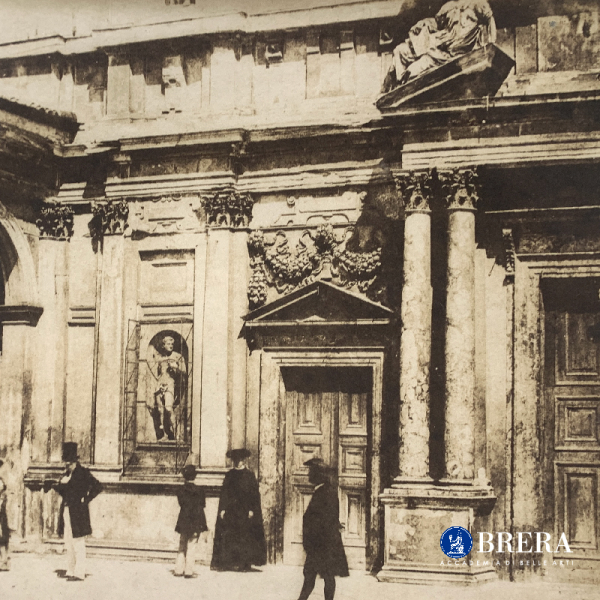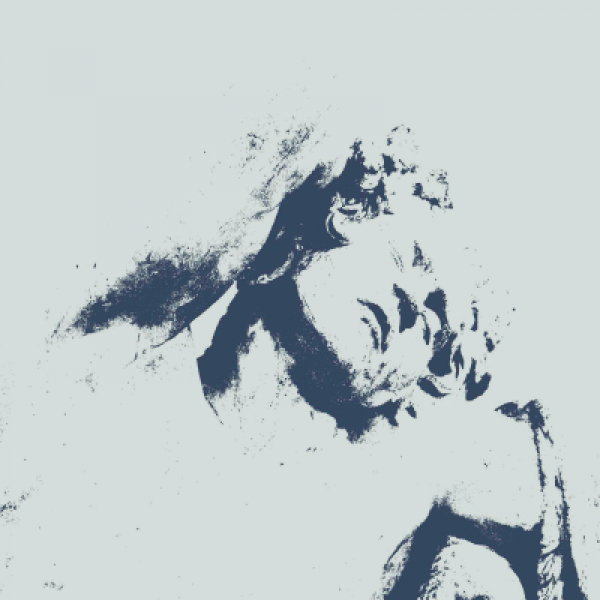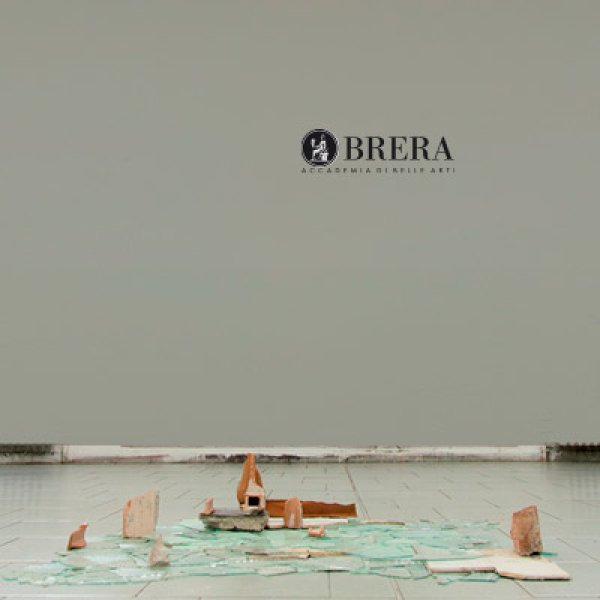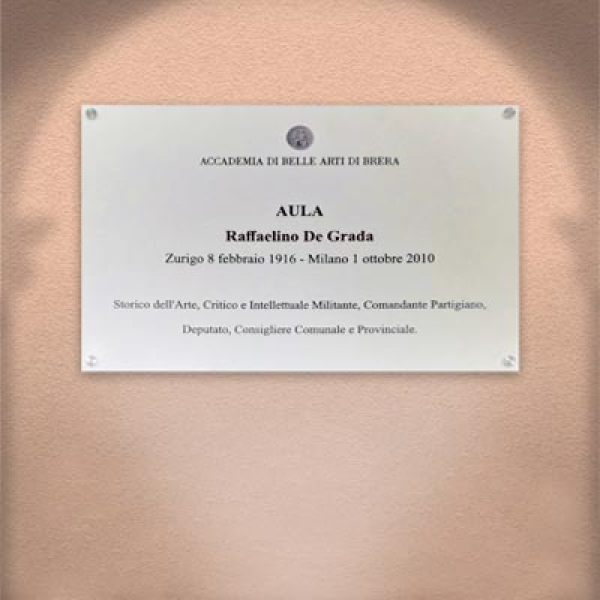Featured News
-

Le raccolte fotografiche storiche nelle Accademie e nelle Scuole di Arti Applicate
-

Erasmus Students Exhibition 2022 – 2023
-

Neimand is perfect. A tribute to Al Hansen - Live
Performance Live -

Inauguration of the Academic Year 2020/2021
27th of February 2021 -

Accessibility services
Accessibility to services -

Coronavirus_Informative
-

Plaque dedicated to De Grada
Event -

Gonfia la rete, vinci sul web
Contest
Diploma Supplement
The Diploma Supplement (DS) is a document founded by the European Commission, the Council of Europe and Unesco/Cepes as part of the Bologna Process to facilitate the standardization of qualifications on a European and international scale. The document is opportune both for those students continuing studies in academic institutes as well as for those entering the world of work.
The document must be filled out in English and in Italian. It supplements and completes the official qualification containing a description of the knowledge and expertise acquired by the student at the end of the chosen course as well as a general description of the national education system.
The document summarizes the following in 8 sections: personal data, educational qualification, level of qualification, information on contents and results gained, function of qualification, additional information, certification of the supplement, description of the national higher education system. Once the document is filled out by the student inserting the title within the Italian Qualification Framework (QTI) it can then be compared to the European Qualification Framework (EQF)
Document Supplement issuance
The DS is issued to all Graduates of degree courses (under the new education system) according to Law n.508 dated the 21st of December 1999
It is issued at the end of each cycle of courses (First Level Three Year courses- Second Level Two Year Courses- Third Level Post Graduate Courses) together with the original educational qualification automatically and free of charge.
Graduates of degree courses under the previous education system are not eligible for the DS (Education Systems preceding Ministerial Decree 508/509). The Accademia has prearranged the issuance of a certificate in Italian and English with the conversion of the exams taken under the new educational system, in accordance to the Ministerial Decree n.50 dated the 1st of March 2012.
For additional information: diplomasupplement@accademiadibrera.milano.it
Moduli
Modulo richiesta Diploma Supplement
Modulo richiesta Certificato Vecchio Ordinamento con conversione in crediti Nuovo Ordinamento
Equipollences
Equipollence degrees AFAM - BELLE ARTI
The Accademie di Belle Arti currently award First and Second Level Diplomas which have been declared equivalent to university degrees, in accordance to Law no.228 , Art 1, clauses 102-107 dated the 24/12/2012 as specified below:
First level Academic Diplomas (three year courses-different systems)
All First Level Academic Diplomas issued in accordance to Law n.508 dated 21/12/1999, are equivalent to degree titles issued by universities belonging to Class L-3, Disciplines of figurative arts, music, fashion entertainment and show business referred to in the Ministerial Decree 16 March 2007 (Official Journal n. 153 dated 6/07/2007).
Second Level Academic Diplomas (two year courses-experimental courses)
Second Level Academic Courses issued in accordance to law n.508 dated 21/12/1999 are equivalent to Master’s Degrees issued by universities as referred to in the Ministerial Decree 16 March 2007 (Official Journal n.155 dated 9/07/2007 belonging to the following Second Level degree courses:
- Class LM-12 Design for Second Level Academic Diplomas issued within the School of Artistic Design for Business:
- Product Design
- Fashion Design
- Class LM-65 Performance Science and multimedia creation for Second Level Academic Diplomas issued within the School of Set Design and the School of Art and New Technologies:
- Set Design-Specialization cinema and TV
- Set Design-Specialization costumes for show business and performance
- Set Design- Specialization theatre
- Set Design- Specialization puppet theatre
- Art and New Technologies-Specialization multimedia arts, cinema and digital video
- Art and New Technologies- Specialization multimedia performance and interactive arts
- Art and New Technologies- Specialization Net Art
- Art and New Technologies- Specialization Photography
- Class LM-89 History of Art for diplomas awarded within the remaining Schools::
- Visual Arts: Painting
- Visual Arts: Sculpture
- Visual Arts: Graphic Design
- Visual Arts: Decoration
- Visual Arts: Art Therapy
- Creative Communication for Cultural Heritage - Specialization Digital applications and communication for Cultural Heritage
- Creative Communication for Cultural Heritage - Specialization Promotional and Expositive communication
- Communication and Art Didactics - Specialization Multimedia Didacatics
- Restoration of contemporary art
Diplomas issued under the previous university system (four year courses)
Diplomas awarded at the end of the previous university system together with a high school diploma are equivalent to Second Level Academic Diplomas.
Final evaluation on the equivalence of second level two year experimental courses and four year courses under the previous university system
This certificate is drawn up according to indications set out in Law 228/2012 and pending final approval by the Ministry of Education, University and Research (MIUR).
Five Year Second Level Academic Diplomas in Restoration
Five year Second Level Academic Diplomas in Restoration awarded according to Law Decree n.302, December 2010, and implemented by the Italian Ministerial Decree n.81 dated 23rd of June 2011, are equivalent to combined Bachelor’s Degree and Master’s Degrees.
These Diplomas are qualifications for the “Restorer of Cultural Heritage” profession according to the following professional training courses:
PFP1-Stone materials and stone by-products. Decorated architectural surfaces
PFP2-Objects painted on wooden and textile supports. Wooden furnishings and structures. Crafted, assembled and/or painted products in synthetic materials
PFP5-Book and Archive materials. Products in paper and parchment. Photographic, cinematographic and digital materials.
Links for further information
Allegati
Stralcio della Legge 228 del 24/12/2012 relativo all’Art. 1, Commi da 102 a 107bis
Aggiornata al 2017
Tabella A del Decreto del Presidente della Repubblica 8 luglio 2005, n. 212
D.P.R. 8 luglio 2005, n. 212
Internships and Apprenticeships
The terms “internship” and “apprenticeship” are commonly considered synonyms. While there are some similarities between them, the two are inherently different. Mainly speaking the internship is a voluntary or in any case optional activity of work based learning while the apprenticeship is a compulsory step in a training or professional path so-called work based training.
With this premise in mind, the terms “internship” and “apprenticeship” will be considered synonyms for their administrative activation procedures.
At the moment, the Internship and Apprenticeship Office activates the curricular internships as set out in the study plan of every single First and Second Level course. All students duly enrolled are eligible.
The duration of the internship is calculated on the basis of the maximum number of academic credits (CFA) indicated in the study plan of the relevant course. Its activation includes a number of different phases which involve a promoter, in this case, the Accademia, a host and the student. The process concludes with the signing of an agreement and an individual training programme.
Apprenticeships can be activated following a direct contact between the student and the host company/organization, subject to the authorization of the Internship and Apprenticeship Office, between the Accademia di Belle Arti di Brera and the host company/organization or following the request on behalf of the host company/organization to the Internship and Apprenticeship Office.
The student, in order to activate his internship, must:
- Check that you are regularly enrolled in an active diploma course at the Accademia di Brera;
- Contact a teacher (tenured, preferably the address teacher) who acts as a tutor informing him about the host and the activity covered by the internship;
- In the event that the teacher, having assessed the consistency of the task with the study plan and its educational and orientation value, agrees to play the role of tutor and authorizes to proceed with the activation, fill in the "Curricular internship activation form" and deliver it to the Internship and Traineeships office with attached copies of the identity card and the tax code;
- Wait for the signing of all documents and their delivery to the Internship and Internship Office before starting your internship.
The host, for its part, must:
- Wait to receive the confirmation e-mail from the Internship and Internship Office, with the draft agreement and training project attached;
- Review the documents, especially art. 6 of the agreement;
- Fill in all relevant sections in detail (parts highlighted in yellow) in both documents under penalty of canceling the activation request;
- Send the drafts by e-mail in Word format (without stamp or signature) to the Internship and Traineeships Office together with a copy of the identity card of the Legal Representative;
- Wait for the authorization of the Internship and Traineeships Office before hosting the trainee.
The Internship and Traineeships Office accepts the activation requests submitted by students and examines the documents sent by the host subject by filling in the fields pertaining to the promoter, inserting the letterhead, printing them and sending them for stipulation through the student.
IMPORTANT:
- The internship is considered active only after the signing of the agreement and the individual training project by all the subjects involved and only after this can it begin.
- The internship is started by the Internship and Apprenticeship Office within two weeks of receiving the activation request together with the draft agreements and the training project.
- The signed and stamped documents must be delivered to the Internship and Apprenticeship Office before the internship begins, otherwise it will be postponed.
- Internships not activated through the Internship and Apprenticeship Office do not have the insurance coverage guaranteed by the policy stipulated by the Accademia di Brera and are not recognized.
At the end of the apprenticeship, the tutor of the host organization must download the “Final Internship Report by the host tutor” fill it in item by item, use the letterhead of the host organization/company, print it in duplicate copies, sign it, stamp it and consign it to the student or alternatively send it to the Internship and Apprenticeship Office by registered post.
The student must take the necessary steps to contact his or her teacher/tutor, arrange for them to compile and sign the “Final Internship Report by apprentice’s didactic tutor”. Students must compile their part and sign the Report and subsequently submit the Report to the Internship and Apprenticeship Office.
Internship and Apprenticeship Office once all the final apprenticeship documents have been obtained, the Office takes the necessary steps to evaluate their accuracy and then proceeds with the registration on the online secretariat.
Companies and public and private bodies looking for profiles between students and graduates of our Academy can submit curricular / extracurricular or job / collaboration internship offers by filling out the appropriate online form.
The form will be received by the Internship and Internship Office which, having assessed the adequacy of the offer, will forward it to students or graduates who meet the required requirements. The latter, if interested, can send their application directly to the bidder.
The Internship and Internship Office activates curricular internships (aimed at students who have not yet graduated) for a maximum total duration of 150 hours, to be carried out in part-time or full-time mode, which can be distributed over one or more months.
Extra-curricular internships (aimed at graduates), currently not managed by the Internship and Internship Office, can be activated through:
- Employment Centers;
- Regional accredited subjects for employment services referred to in l.r. 22/2006;
- Regional authorized subjects for employment services referred to in l.r. 22/2006, which include the special regional authorities, as provided for in the DGR of 18 April 2007 no. 4561.
The legislation on extracurricular internships (Lombardy Region) provides for the compulsory participation allowance, the amount of which is defined by the parties and cannot be less than 500 euros per month, gross of any withholding taxes.
OPENING TIMES AND CONTACTS
Monday, Tuesday, Wednesday, Friday from 10.00 to 14.30.
CLOSED Thursday.
Ph. Apprenticeships office 02.86955361
Ph. Orientation office 02.86955363
Fax. 02.89054850
Forms
List of all courses CONVENTIONS
Update 11/2022
List of Therapeutic CONVENTIONS
Update 11/2022
Request for activation of Curricular Internships
Updated the 19th of October




